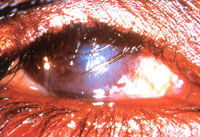Background: Blindness from trachoma and trichiasis
November / December 2012 | Volume 11, Issue 6

Photo courtesy of WHO
Repeated, untreated infections and
scarring forcing the eyelashes to
turn in and scrape the cornea in a
condition known as trichiasis.
Trachoma is currently the leading infectious cause of preventable blindness worldwide. Repeated, untreated infections over years build scarring on the inside of the eyelids and make the eyelashes turn in - a condition known as trichiasis. This scrapes and irritates the cornea, compromises vision and eventually causes blindness.
Trachoma remains a significant public health concern in many developing countries, especially in regions that suffer from overcrowding, water shortages and poor hygiene. Infection spreads from person to person, usually among children, through contact from hands, clothes, or flies that carry discharge from the eyes. Due to their close contact with children, women suffer three times more infections than men.
The WHO estimates that 40.6 million people suffer from active trachoma and 8.2 million have trichiasis. Hardest hit areas are in the Middle East, North and sub-Saharan Africa, India, Southern Asia and China.
To tackle this misery, the
WHO launched a trachoma elimination strategy, called "SAFE," involving trichiasis surgery, antibiotics and improved hygiene, which it hopes will succeed by 2020.
More Information
Articles in the Focus on the National Eye Institute at NIH section were produced by Cathy Kristiansen, with contributions from Christopher G. Thomas, Tom Hoglund and Richard S. Fisher.
To view Adobe PDF files,
download current, free accessible plug-ins from Adobe's website.